Posts
Now that the series is complete I thought it necessary to create somewhat of a master post that aggregated all of the entries more effectively. Also included are some new photographs.
- Trip planning for the 100 mile wilderness (2010-06-07 @ 22:25)
- The final countdown (2010-06-13)
- Trip report #1: The beginning through Day 2 (2010-06-28 @ 18:32)
- Trip report #2: Day 3 through Day 5 (2010-07-04 @ 15:46)
- Trip Report #3: Day 6 through Day 8 (2010-07-17 @ 00:33)
- Trip report #4: Afterward and Final Thoughts (2010-08-08 @ 23:04)
1. Trip planning for the 100 mile wilderness (2010-06-07 @ 22:25)
The series begins with an overview of gear and the trip itself. Nearly every item is catalogued and the choice to bring it is rationalized.
2. The final countdown (2010-06-13
Hours before leaving, this final post documents some last minute decisions and briefly discusses the strange mixed sensation of apprehension and anticipation.
3. Trip report #1: The beginning through Day 2 (2010-06-28 @ 18:32)
Chronicles the drive up to Maine which included a stop in Connecticut, and the first two days of the hike. Notable media includes videos and photographs taken during the flight from the northern end of the wilderness to our starting point at it's extreme southern end. By the end of the second day we realize that we are not progressing at the speed which we had counted on and had underestimated the difficulty of the trail.
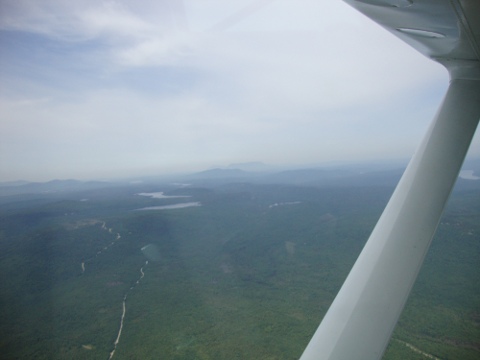 Right after gaining a bit of altitude as the plane left the water
Right after gaining a bit of altitude as the plane left the water
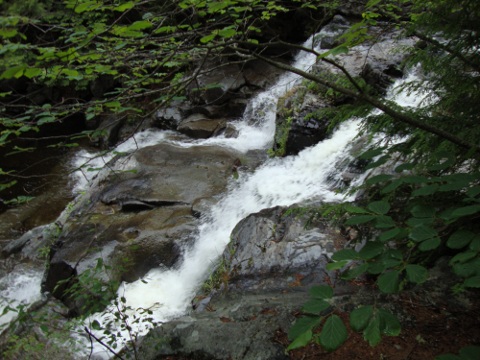 A smaller waterfall hidden behind some thick vegetation
A smaller waterfall hidden behind some thick vegetation 4. Trip report #2: Day 3 through Day 5 (2010-07-04 @ 15:46)
Zach's condition deteriorates as we continue to face the rough terrain in the Barren-Chairback range. I leave Zach alone on the morning of the fourth day to face the rest of the hike alone. Spectacular photographs from White Cap Mountain and its surrounding peaks. The fifth day includes 19 miles and five peaks which inflicts damage to my already damaged feet.
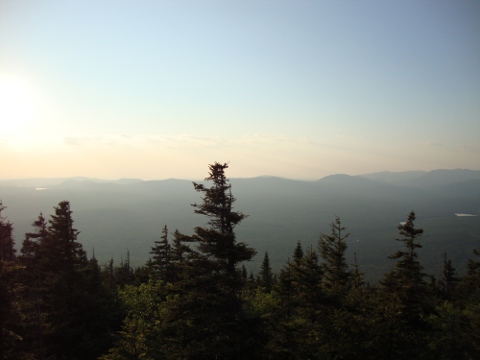 Awe-inspiring sunset from the top of Barren Mountain
Awe-inspiring sunset from the top of Barren Mountain
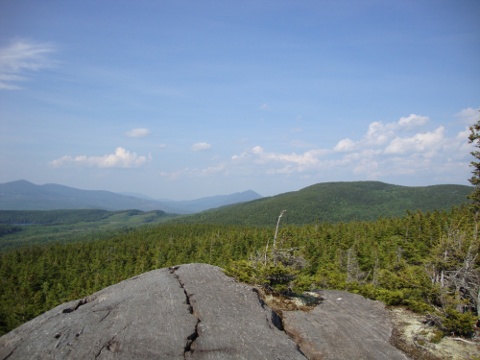 One of many smaller peaks in the Barren-Chairback range
One of many smaller peaks in the Barren-Chairback range 5. Trip Report #3: Day 6 through Day 8 (2010-07-17 @ 00:33)
I pay a visit to an infamous wilderness camp known as White House Landing. After leaving the camp, I aim to finish the remainder of the trip in two days. Without doubt, these were the most mentally challenging hiking days I have ever experienced. After eight days in the wilderness I emerge from the woods to find myself at Abol Bridge.
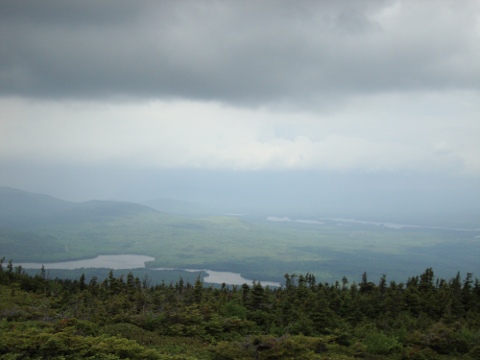 Maine: Lakes, mountains, and trees
Maine: Lakes, mountains, and trees
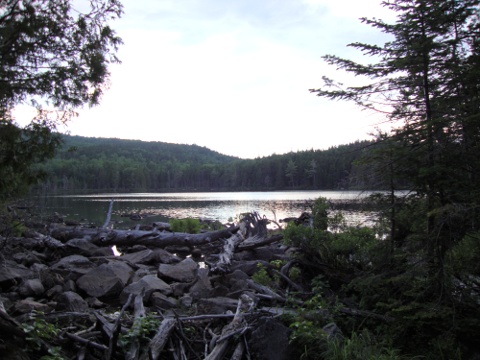 Sunset over a quaint pond
Sunset over a quaint pond
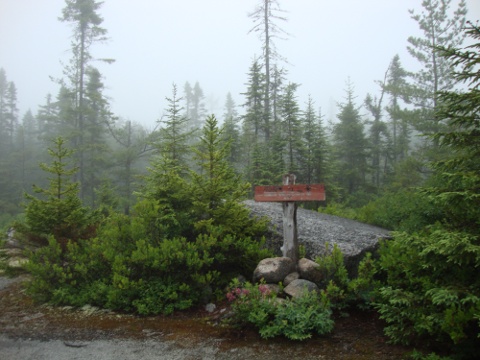 The ethereal mist encountered on the final day of the hike
The ethereal mist encountered on the final day of the hike 6. Trip report #4: Afterward and Final Thoughts (2010-08-08 @ 23:04)
After more than a month has passed since the completion of the hike I wrote this final post that reflects on the events of the trip. Originally intended to be a gear assessment, I decided to make it much more story-driven and reflective of things I experienced on the trip. Completes the series.
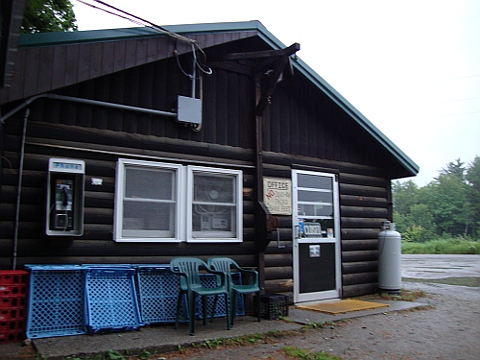 No skittles here
No skittles here Trip report #4: Afterward and Final Thoughts
[Category: 100 Mile Wilderness] [link] [Date: 2010-08-08 23:06:53]
More than a month has passed since I completed my hike of the 100 mile wilderness section of the Appalachian Trail (AT) in Maine. I intentionally delayed the writing of this final report to allow myself extra time to more fully appreciate the experience I had and to contemplate both the positive and negative highlights of the trip. The most pressing question I have experienced from interested parties has been one of curiosity about whether or not I intend to pursue another trip of the same magnitude or challenge. At the moment, the answer is that I do not. While it is unlikely that I will never feel the urge to wander off into the woods and leave behind the stresses that linger around everyday life again, it must be recognized that trips of such lengths require immense planning and the investment of considerable amounts of money and time. One of the most difficult aspects of the 100 mile wilderness was resupplying (more accurately, the complete lack of) and I do not intend to ever carry eight to ten days of food again.
While the hike was a mixed bag of experiences, at the core of it was a 100 mile stretch of difficult terrain that separated two ends of a largely unpopulated area that is the most forested region of the eastern United States. This distance turned out to be about 30 miles and three days beyond my comfort zone. In todays world of hyper-civilized suburban bliss it is difficult to imagine eight days that lack some simple material objects that are often taken for granted. Detach yourself from the comfort of your current condition for a brief moment in time. Remove the roof above your head, the climate controlled temperature around you, the chair you are sitting on, and the clean clothes on your back. Instead of waking up to the sound of an alarm clock that signals the beginning of the morning commute, you arise each day when your body summons you to begin walking for no other purpose than to move from one place to another. The end of each day yields no soft cotton sheets draped over a cushioned mattress, no faucet from which to obtain seemingly infinite quantities of water, and no fridge or pantry stocked with a cornucopia of nourishing foods. After all of the struggle of the day, you cannot reward yourself by collapsing onto a lavishly upholstered sofa and submitting to mindless television programs displayed on a gratuitously large high definition flat panel. Most integral to the experience is to imagine that every step taken forward must be completed, at some point, with the added weight of whatever items you deemed impossible to leave behind.
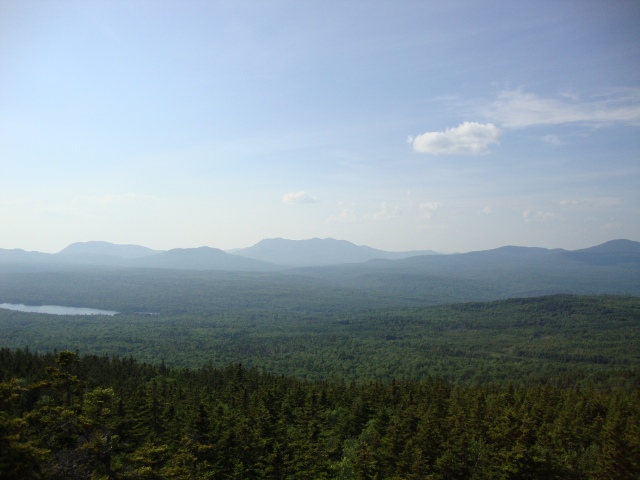 Typical view from atop peaks along the AT in Maine
Typical view from atop peaks along the AT in Maine Let us switch gears for a moment. The hike was difficult. Without doubt, it tested me and, in the end, this was my intention. I can't possibly convey how such a simple object as a chair, a cotton sheet, or a favorite drink or food can come to mean to someone who is deprived of them for any measurable length of time. Part of the experience was the difficulty and the hardship and I wouldn't have it any other way. Having the comforts and safety of civilization stripped away forces a re-examination of what is truly necessary and important. What if everything that you owned had to be carried everywhere you ever went? It's a heavy question - at least in terms of its philosophical implications and the weight of such items as your car, wardrobe, and CD collection. If attachment truly is pain, then being deeply inseparable from your material possessions would be nothing short of suicide.
Assessing my gear choices was a relatively simple process. If I didn't use it through the whole hike it was entirely useless. If I used it less than three times the whole trip it was expendable. If I was annoyed with it, it should be replaced or changed. My choice to not purchase a new backpack led me to use a much older backpack that I was more comfortable with but it came with the expense of being slightly heavier than the alternatives. I was proud of my initial weigh out of approximately 37lbs, but it was still about 17lbs beyond what I think I really need to aim for if I desire any degree of comfort while on an extended hike. The MSR Hubba HP tent was a phenomenal performer, withstood adverse conditions, and was adaptable for a variety of situations. Despite this versatility, the realization that shelter hopping is the most viable option on most long distance trails has led me to consider an ultra-lightweight tarp as an emergency shelter rather than carrying around two pounds of tent that gets used so seldomly for its intended purpose. My decision to acquire Zach's extra hiking pole for the hike proved to be a wise one. I no longer can imagine doing any serious hiking without a good trekking pole and I will, without doubt, be investing in some lightweight trekking poles. The only item that I am still torn on is the MSR SweetWater purification system. I absolutely love the fact that I can get clean water that is both filtered and treated from nearly any water source but the field maintenance on this item was excessive and it required constant attention. Choosing to use tablet purification could potentially save another 16oz of weight at the expense of guaranteed clean water.
On numerous occasions I have been asked how much I spent on this adventure. The answer is hard to pinpoint with any kind of considerable precision since a majority of the investment was done over an extended period of time. I will say that I made a fair contribution to the rural economy of northwestern Maine. It became clear to me that there are people who make their livelihoods off of the hikers that stagger off the trail to find refuge in the rural towns of Millinocket and Monson. Don't be fooled, though. The largest industry in this region of Maine is logging. It dwarfs any other activities in the region in terms of its importance to the economy. Trees are a resource and they can be managed wisely, but it still hurts at some kind of primitive level to see truck after truck exiting the forest with loads of timber. The particular region of Maine that I was hiking through has been logged nearly completely over three times and vast tracts have been devastated by wildfires in certain areas. To my surprise, there was no evidence of tension over the activities of the loggers and the willingness of many logging companies to sell land to the MATC to form a protected corridor around the trail is heartening. Throughout the 1950's and 1960's the trail in Maine winded through the forest and passed numerous wilderness camps that were owned and operated by logging companies. AT hikers were allowed to use them for decades before the wilderness camps slowly began to disappear and fall into disrepair. White House Landing is simply a remnant of what once was a continuous network of camps along the trail.
Go anywhere in the country and you are bound to find a town, city, hamlet, or region that claims to define what hospitality truly means. Lore had indicated to me that many hikers found the residents of rural Maine to be of the most exceptional quality when it comes to being hospitable and kind. At first examination I assigned this claim to the fact that the weary hiker, having slogged thousands of miles from Georgia to Monson, would have a decidedly altered view of the world and the people who occupy it. Anyone willing to help them, provide them with a place to sleep, or cook them up a hearty breakfast would be no less than an angel in their eyes. To my surprise, the legends were beyond true. I encountered no people who were anything short of courteous and all of the places I stayed provided exceptional service. The true nature of how kind the residents of rural Maine are to strangers is evident in their actions which go above and beyond the call. Zach, after getting sick, was taken out by fishermen that we had just met moments prior to asking them for assistance. He was driven back to Monson where he stayed indoors (Dawn at Shaw's refused to let him stay outside since he was sick), and was even invited to be the grill master at a cookout. Everyone I met from Monson to Millinocket was helpful and it was only younger teenagers who seemed to glare at hikers with a certain sense of judgment evident in their facial expressions.
Preparing physically for the hike was a task in itself. Early on I resolved to push aside the complacency of believing that I would simply make my way through it with brute force. For a twenty-something year old male this is harder than it sounds. Leading up to the trip I ran two to three miles at least three times a week (often four), and went on two test hikes that included distances of ten miles and twenty miles. I could have done more. Running for twenty minutes is a much different experience than climbing five mountains and covering 19 miles in a day. I was strong, but my endurance often left me taking breaks at intervals that seemed to grow closer and closer together as the day dwindled onward. It is difficult to prepare for such a hike since the activity is very dissimilar to many other activities that are readily accessible. The rocks and roots, the scrambles up loose earth, and the extra weight on your back are all aspects of a challenging hike that aren't usually replicated during preparation. Most miraculous was my ability to maintain a body weight. Upon departing Connecticut, I weighed myself at 145lbs. For me, this is quite a feat when one considers that I spent the better part of my late teens weighing 128-132lbs. Thanks to my rabid metabolism, it is difficult for me to gain and maintain weight. It is beyond me how I still weighed 145lbs when I arrived back in Cincinnati. "How could that be?!" I thought to myself. I spent the better part of each day during the hike obsessing over what I would let myself eat that night and most days ended with feelings of weakness and hunger. Either I estimated caloric intake much more accurately than I had thought or the extra weight was a result of building up muscle mass. I may never truly know. Since returning home I have steadily lost weight and am now weighing in at a solid 137lbs.
Hikers often desperately seek companionship to alleviate some of the difficulties of dealing with struggles that they are faced with while hiking the trail. I was no different. Zach was someone I knew would be crazy enough to agree to attempt such a feat with me, and I was more than glad that we were in it together. His absence changed the experience dramatically for me. There's a certain familiarity that comes with hiking with someone you know. It is comforting to be around a person that you trust and he or she can often correct your personal errors or provide input if an important decision has to be made. While alone, the amount of self-reliance that a hike of this distance requires is forcibly brought forward and is no longer masked by the safety of having a companion around to defer to. You are made both free and captive by your own thoughts. At times, I would catch myself speaking as if I was talking to two different halves of myself. The mix of solitude and loneliness was nothing short of confusing and frightening and I often debated with myself which emotion I was feeling at any given moment.
While hiking alone I was left with excessive amounts of time to spend with nothing more than my own thoughts and the variety and strangeness of the emotions that I experienced was daunting. At times, I would find myself having traveled an unknown distance along a path I did not remember for a length of time I could not recall. Then there were moments where nothing existed except a simple happiness that came with the resolution to change something about my life or to do something out of the ordinary. After completing the hike and returning home, I followed up on most of my self-created commitments and resolutions, despite the difficulty that was associated with some of them. I was driven by the recollection of how strongly I felt about them while alone in the wilderness. For some reason, it feels as if the thoughts that surfaced while alone in Maine were somehow more pure and true than those that present themselves on an everyday basis.
Ending the last trip report is a task that I had not looked forward to. I have chosen to end it abruptly with one last nugget of text. It is something that I find difficult to do, so I have chosen to end this series by repeating it in an attempt to remind myself of its importance.
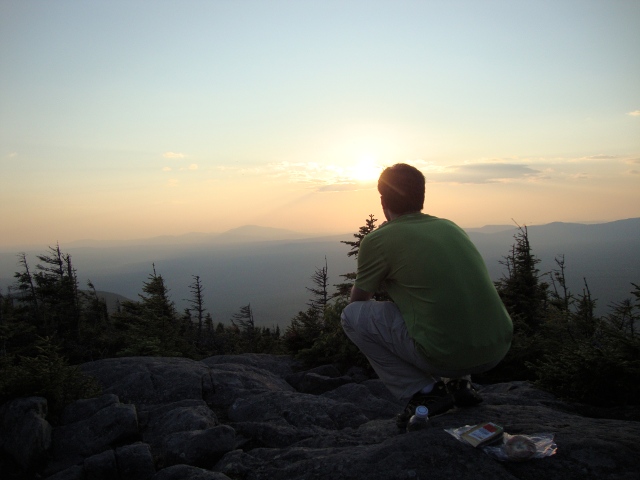
"It is far more difficult to find happiness in the things that you do have than it is to believe that happiness lies in something that you do not have."
Trip Report #3: Day 6 through Day 8
[Category: 100 Mile Wilderness] [link] [Date: 2010-07-17 00:47:56]
Day 6: Monday, June 21 (Cooper Brook Falls Leanto to White House Landing) 14.1mi (+1.2mi)
Early on in the hike I came to the conclusion that aiming to spend an evening at White House Landing (WHL) would be a good way to help me mentally and physically cope with the rigors of the hike. WHL is a well-known wilderness camp that willingly accommodates hikers. After the abuse of the previous day, I woke up determined to reward myself with some comforts at WHL. Dinner ended at 6PM which meant I would have to arrive prior to that time to enjoy a proper meal, a roof over my head, a much needed shower, and a hearty breakfast. My trip planning did not involve any resupply at WHL so it was not a necessity in that respect. Nonetheless, I had convinced myself that it would do my body well to have half a day of true relief. The morning had revealed blisters on nearly every toe and both heels and my feet cried as I slipped on my hiking shoes in spite of the immense care I took to loosen them. The hardest part of dealing with blisters on the trail is that they rarely improve. I had to continue knowing that the condition of my feet would worsen.
Throughout the day I encountered numerous southbound hikers who all shared a similar story. "We just started and we're going to Georgia!" they all exclaimed with enthusiasm. During my crossing of the Barren-Chairback range I saw an average of two to three hikers a day. Suddenly I was running into hikers (typically in pairs or groups) every hour. It did not take me long to surmise that the onslaught of southbound thru-hikers had begun. I had scheduled my northbound hike of the wilderness at a time when vast numbers of optimistic hikers were starting their southbound thru-hikes. This new volume of hikers increased throughout the last three days of the trip and it changed the experience of the hike dramatically for me.
With my mind set on reaching WHL I had to mentally negotiate a middle-ground of mile-crunching and enjoyment. I settled on building in time for an extended stop at lower Jo-Mary Lake which turned out to be very beneficial. There was a beautiful sand beach which almost appeared to be a small tropical paradise as I stepped out from the dense vegetation that surrounded the lake. I threw off my shoes and shirt and enjoyed a cool swim in the near-frigid lake. With the heat in the low-lying lake land I would dry in less than an hour anyways. Extra time was spent letting my feet breath and relax in the cool water. Blisters were now a huge issue and required constant attention and care. As I was tending to them, a short, gray-headed man emerged from the forest. He had a striking resemblance to a professor I had in college and appeared to handle himself in a similar fashion. We talked for a little bit and I gleaned a bit more information on how to find my way to WHL along with a demonstration of how he used birch bark to brace his shoe which was causing awful blisters on the back of his feet. I left him to enjoy the beach alone and disappeared back into the sun-speckled foliage of the trail.
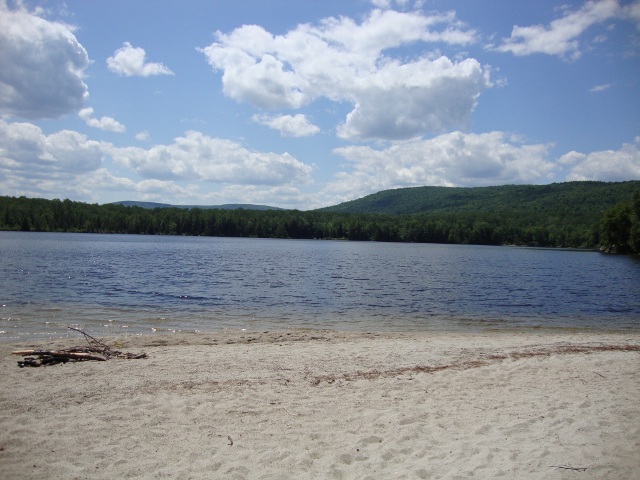 My little tropical paradise in Maine found on lower Jo Mary Lake
My little tropical paradise in Maine found on lower Jo Mary Lake Unfortunately, my break at the beach had consumed more time than I had originally planned for which led me to quicken my pace considerably. My mind raced and I began to experience the hike in a much different way. Unlike the previous days where I was concerned with foot placement, what mile I was on, where I would next find water, and how far the next shelter was, my mind began to automate these concerns and I began to think much more deeply about issues unrelated to the trail. I questioned why I wanted to attempt the hike, how it was that I had found myself alone again, whether or not I'd want to finish the hike after reaching WHL, and other questions that really had no answers. It became common for me to comment on things to myself. If I misplaced a step and slipped on a root I'd say "Whoa, easy there..." as if someone else was there and I had been watching them. I began to make numerous resolutions and decisions about what I would do when I completed the hike. I decided that I would try to pursue these thoughts and feelings when I returned since they seemed to come up with immediate importance even when the current situation had no bearing on them whatsoever.
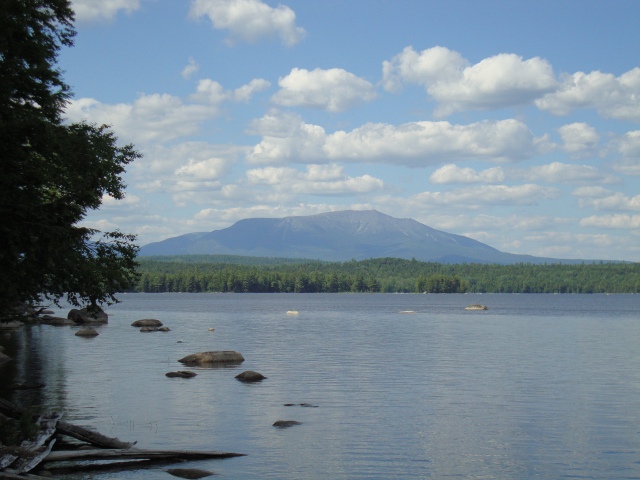 There were numerous views of Katahdin from the shores of lakes
There were numerous views of Katahdin from the shores of lakes All of the sudden I found myself at the Mahar Tote Road. On the trail it is marked as an arrow pointing towards Mahar Landing. It was not even 5PM, but I knew that there was still another 1.2 miles of hiking to be done in order to reach the dock where I could call for a ferry across the lake. On the 2009 MATC maps this is actually marked by a state campsite indicator. The side trail that leads to WHL ended up being the most obsessively marked trail I have ever encountered. It seemed to wind on forever down the shore of Pemadumcook Lake before I reached the dock. At the dock is an air horn and instructions to blow one short blast in order for a boat to come pick you up. After blowing the horn I rested on the dock as I watched a man come over in a speedboat to fetch me after only five or so minutes. I said hello to Bill and he took me back to WHL. I never imagined that things like grass, a glass window, and buildings would look so foreign. He led me into the dining area where I was presented with the important decision of what I wanted for dinner. I explained that I was a vegetarian and he promptly pointed out that they provide Boca burgers. I settled on two Boca burgers that were topped with anything they could find. I became the first person to ever eat a double Boca deluxe and I am quite confident I could have consumed a third.
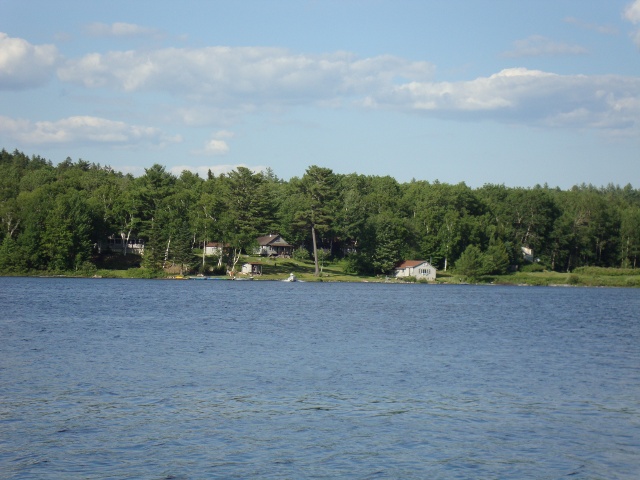 White House Landing from across Lake Pemadumcook
White House Landing from across Lake Pemadumcook While in the dining area I met the others who were currently staying at the wilderness camp. My blister-covered toes and feet were wrapped in blood-stained tape and I caught most of the guests giving them a strong stare at some point during my Boca binge. There was a group of three which included a father, son, and the sons friend. The father initiated a conversation with me and after some time revealed that he had lived in Cincinnati as a child. We exchanged stories about the local sports teams and chili parlors (it's a big deal in Cincinnati). He was quite talkative and revealed that this was his second time attempting the wilderness. The previous year he had to be evacuated from Potaywadjo Leanto due to an infection that started in a huge blister on his foot. It eventually spread up his leg and got so severe that he now brandishes a scar on his leg that appears similar to an area of freshly sunburned skin. The only two others were a couple from Texas that were recently married. Their southbound hike was cut short when the young woman received a call from a potential employer in Houston about an interview. I was quite confused with the couple. They appeared amazingly unscathed from their first 32 miles in the wilderness and both were well-groomed and neither even remotely fit the hiker stereotype. They had taken a leisurely four days to complete the first 32 miles which is neither challenging nor strenuous compared to the next 70 they would have to complete. I would definitely have felt concern if they had been continuing southbound.
Linda (Bill's Wife) kindly called Shaw's in Monson for me where I was able to speak with Zach for the first time since we had said goodbye at West Chairback Pond. I was glad to learn that he was safe and feeling much better. He congratulated me on reaching WHL and gave some encouraging words for the rest of the hike. It was nice to speak with him again - it was the only familiar voice I had heard in quite some time. Linda spoke with Dawn at Shaw's for a bit and then showed me the restrooms, shower, and bunkhouse. Upon entering the bunkhouse I chose a ragged old mattress and pillow and immediately sought a much needed shower. The water at WHL is all pumped from the lake and there is no electricity. Showers are thus limited to 5 minutes of hot water. All of the buildings are lit by gas lanterns. Some extremists claim that a visit to WHL dilutes the wilderness experience but I would argue that it only enhances it. It's not like you're returning to civilization at all.
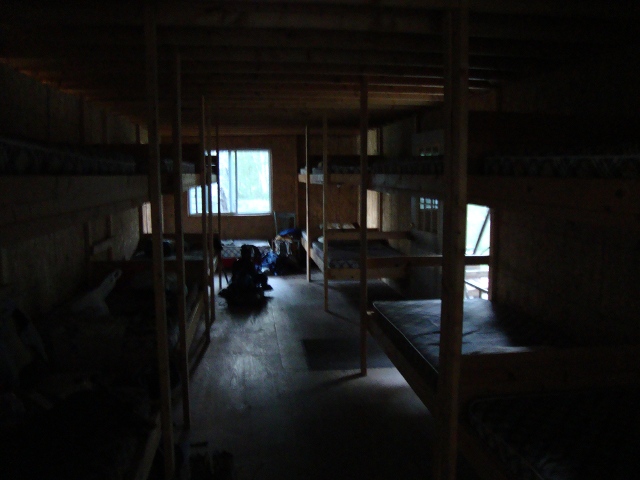 The inside of the bunkhouse at White House Landing
The inside of the bunkhouse at White House Landing For the first time in days I had an evening of rest after I finished enjoying the brief shower. I got to know my other three bunkmates as we all relaxed watching the sun set over the lake. My blister routine was interrupted by the father who furnished me with an entire blister kit complete with medical tools I can't even name. I decided that calling him "Mr. Blister" was only appropriate. The kit sported various tools, ointments, pads, tapes, and bandages. He shared his knowledge of the world of blisters and provided me with some useful moleskin patches and advice on how to cope with the constant threat of blisters. After following his prescriptions the largest blisters on my heels were never a problem again. After the son and his friend finished a game of chess a discussion began about the book that the son had picked up upon arriving at WHL. It was written by a Russian author and I immediately commented that it was probably a somewhat depressing tale of a tortured soul. The son defended his choice and handed it to me where I read the back cover which described the novel as an enthralling tale of suffering, hardship, and a man forced to confront his largest fears. I felt my diagnosis was accurate. After some small talk, the three went to sleep and I watched the last minutes of twilight disappear before crawling onto the mattress which showed its age by squeaking and moaning obnoxiously with even the smallest shift in body position.
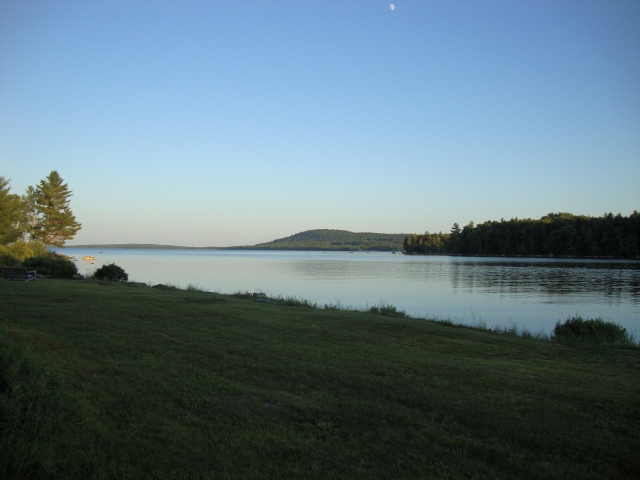 Earlier on in the evening looking out over the lake at White House Landing
Earlier on in the evening looking out over the lake at White House Landing Day 7: Tuesday, June 22 (White House Landing to Rainbow Stream Leanto) 15.8mi (+0.2mi)
My body at this point had been trained to rise early. I woke up at 6:30AM, packed my gear, and walked over to the dining house where Bill was cooking up a hearty breakfast of eggs, bacon, and pancakes. I was somehow the last to arrive at breakfast and ended up cleaning out the remaining eggs and juice and followed it up with four pancakes. The father and son group were being driven to Millinocket where they would catch a bus to Bangor to fly home to Florida while the cute couple were utilizing Katahdin Air to get to Bangor and to fly to Houston. I would be resuming the trail alone once again. As a side note I will mention that along the trail I met hikers who spoke of the extortionist prices at WHL but I find that claim to be relatively baseless. One night includes breakfast and is only $39. Dinner costs extra, but my total bill did not add up to $60 for my entire stay. It was entirely worth it.
Bill discussed with me how many hikers are taken out from WHL each year and explained that it was not abnormal to have those staying the night end up seeking an exit from the wilderness. Last year was particularly harsh due to record rainfalls. We then hopped back into the boat and he took me to within .2 miles of the trail which saved me an entire mile of walking to start the day. I thanked him and he wished me luck before turning the boat around to head back to the wilderness camp.
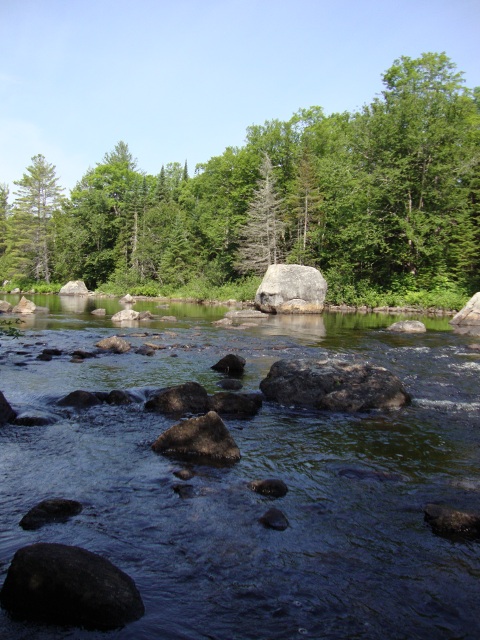 Nahmakanta stream
Nahmakanta stream
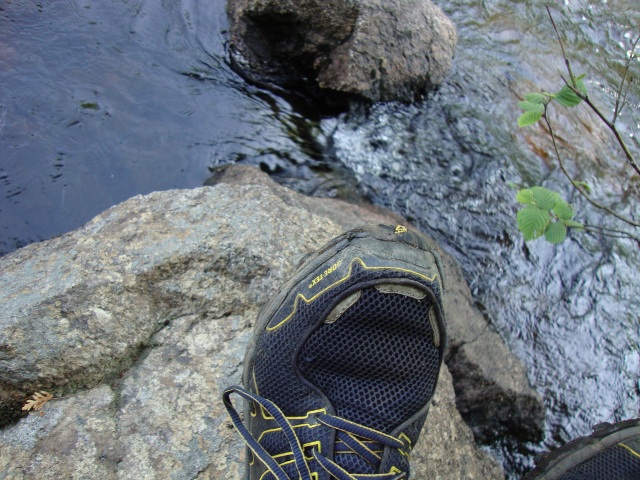 My Roclite GTX 312 shoes were showing some serious wear and tear
My Roclite GTX 312 shoes were showing some serious wear and tear Following Nahmakanta stream northward, I started my hike motivated by the fact that I would soon be entering the third and final map of the hike. Nothing screams progress like seeing a new unstained map. Invigorated by my stay at WHL, I sped through the trail stopping to take relaxing breaks by the stream until I walked into a clearing to find Wadleigh Stream Leanto. Throughout the wilderness it is not uncommon to find discarded items that hikers have discarded in desperate attempts to lighten their packs. Now that I was close to the northern end of the wilderness and there was a large influx of southbound hikers the occasional item changed into entire shelves full of unwanted items that once added weight to a burgeoning pack. The side of the trail was littered with cotton sweatshirts and jeans while the shelters had items such as nail polish, CD players, climbing rope, and entire fishing tackle kits. I amused myself by observing a courageous chipmunk who coaxed me into feeding him some of my Powerbar until a rather large man emerged from the trail. He had completed a thru-hike in 1995 and returns each year to hike the wilderness. After initial introductions, he described Springer Mountain in Georgia in March (southern terminus of the Appalachian Trail) as being an emporium of gear littered along the trail. Before I pushed on we compared gear and pack weight. He had started with 17lbs of gear for the entire wilderness and intended on completing in only four or five days.
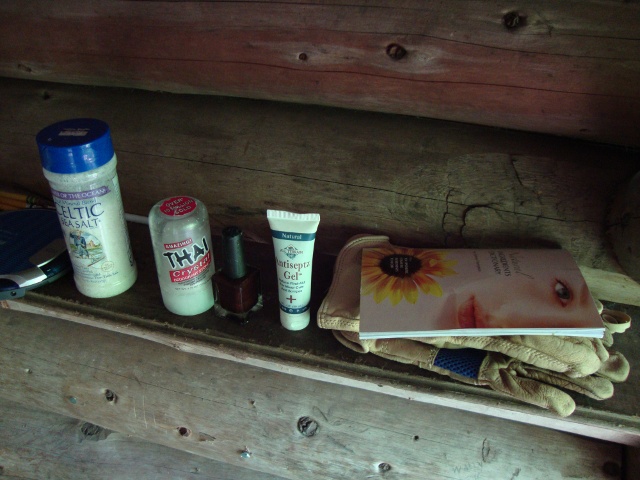 Some of the abandoned items at Wadleigh Stream Leanto
Some of the abandoned items at Wadleigh Stream Leanto
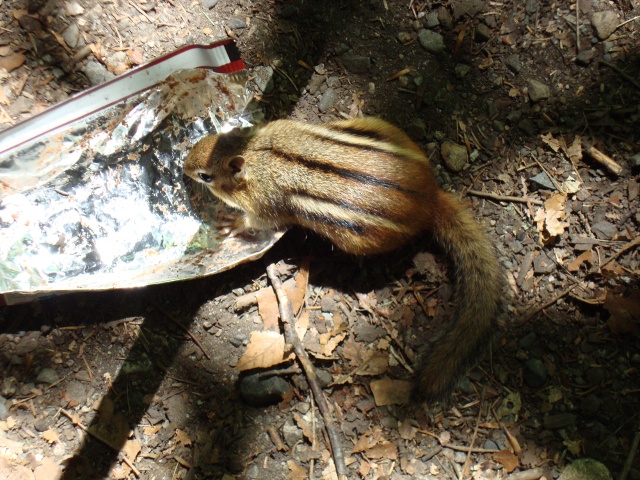 A fearless chipmunk who has probably been fed way too many energy bars
A fearless chipmunk who has probably been fed way too many energy bars
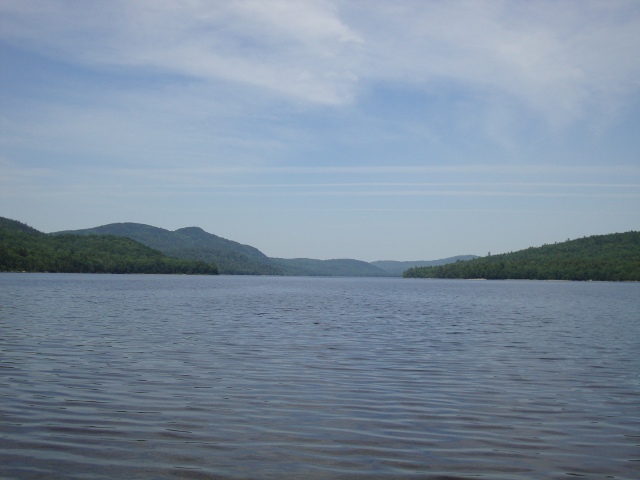 View from another quaint lake along the trail leading up to Nesuntabunt Mountain
View from another quaint lake along the trail leading up to Nesuntabunt Mountain Nesuntabunt Mountain was the only remaining challenge for the day and is a relatively unrewarding climb sparing the rock cliff that provides views of Katahdin which is now the dominant feature of the landscape. Having watched it grow in the past three days had been an encouraging sign of my progress. The trail on Nesuntabunt was less than enjoyable due to its very strange placement, lack of clear blazes, and lack of management. At this point of the hike I was becoming somewhat discontent and irritable as the trail winded back and forth and oscillated direction in such a fashion that I was never sure which way I was truly heading. There were multiple times where I swore I was walking backwards since the path of the trail more closely resembled the scribbles of a toddler than a hiking trail. After finishing Nesuntabunt, the terrain became increasingly boggy and muddy as I entered the last miles of the hike. The trail, which was already dominated by roots and rock, became a single mass of root and large rock fragments which tortured my feet in a way like they had not experienced previously. In locations where a break from the roots and rock was offered my feet suffered from the ever-present moisture. It was evident to me that the last day of the hike would be the hardest on my feet yet.
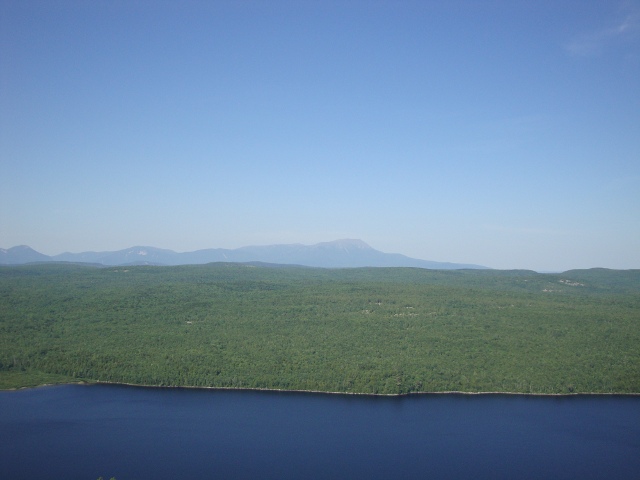 View of Katahdin from a rock cliff near the summit of Nesuntabunt Mountain
View of Katahdin from a rock cliff near the summit of Nesuntabunt Mountain Battling the roots and rocks eventually led me to Rainbow Stream Leanto where there was a single occupant. I debated for 10-15 minutes on whether or not I should push on to the Rainbow Spring Campsite which would make my final day of hiking shorter and more friendly towards my feet which were deteriorating rapidly. Throughout the day it had been spitting rain and I decided that the comfort of the shelter was worth taking advantage of. I occupied the shelter and met the other occupant who had been napping in his tent which was cleverly placed in the shelter much like I had been utilizing the MSR Hubba HP inner wall. He had just graduated from Cornell University in the spring and had amassed $200,000 in debt while pursuing an engineering degree. Throughout the evening we talked and it was clear that we understood one another well and we both appreciated the same kind of sarcastic humor which is common in my generation. He was keen to find out about some of my strategies and asked many questions about the trail, cooking, food, and foot care.
I had seen more southbound hikers than any previous day and all of their stories were the same. They were mostly couples or groups and all had the same story. I ceased the ritual of asking each person where they started and where they were going since their stories were all the same. "We're going to Georgia!" they would all exclaim with such enthusiasm and optimism that it was almost nauseating at times. My shelter mate was no exception, though he was clearly more prepared and was commencing a solo hike. For him, hiking the entire Appalachian Trail was a better option than immediately confronting the massive debt that awaited him back home. While I always wished each hiker the best, the obvious lack of preparation that many of them exhibited was both worrisome and disappointing. It was their discarded gear that would continue to litter the shelters and the trail.
As I tended to my feet the other shelter occupant cringed as I exposed tender skin by unwrapping bloodied bandages. He winced as I drained the larger blisters and I assured him he'd find himself in my position before too long. Before bedding down for the night I had to consider what my plan of attack would be for the final day of the hike. I desperately wanted to complete the hike the next day, but the issue was complicated by a folly that I committed on the morning of the fourth day. When Zach had departed, I left him with the key to the car which was parked at Abol Bridge under the belief that he would find his way there at some point. He had been shuttled back to Monson and had opted to be shuttled to Abol Bridge on Thursday (a day after I would be finishing) with a group to save money where he would then finally get access to the car. The first option was to stay at Hurd Brook Leanto which was only 3mi away from Abol Bridge. I had no intention of taking this option at this point. The second option was to finish the hike then stay at a campground near Abol Bridge and wait for Zach. This seemed realistic at the time, but I had honestly had enough of the outdoors and had quite a burning desire for a proper bed, sheets, a shower, and a few good meals. This led me to opt for the third option which was to hike to Abol Bridge then call for a shuttle into Millinocket to stay at a hiker lodge.
I slept well until the rain began to fall with an intensity like I hadn't seen before in Maine. It continued throughout the night and into the morning where I knew it would be ongoing throughout the last day of the hike.
Day 8: Wednesday, June 23 (Rainbow Stream Leanto to Abol Bridge) 15.0mi
Sporadic rain the previous day had given way to showers during the night and neither I nor my shelter mate had any desire to trudge out onto the muddy trail. At least I had the luxury of it being the last day of my hike. The rain did not cease for the rest of the day and eventually infiltrated my waterproof hiking shoes from the top down. Moisture opened up a new door of pain for my feet and each step eventually required a teeth-clenching effort. My left pinkie toe was in the worst condition and the blister swelled enough by midday that it was pressing upwards against the toenail. I was at risk of losing the toenail and each wrong step I made that wrongly placed pressure onto the toe sent a painful reminder of its condition. Any bandages I placed on the feet were rendered useless by the inundated shoes. I managed to shift my thoughts off of the pouring rain and the poor condition of my feet by focusing on completing the hike. I resolved to buy a cold soda and some skittles (I love them) at the Abol Bridge store as a reward for completing the hike.
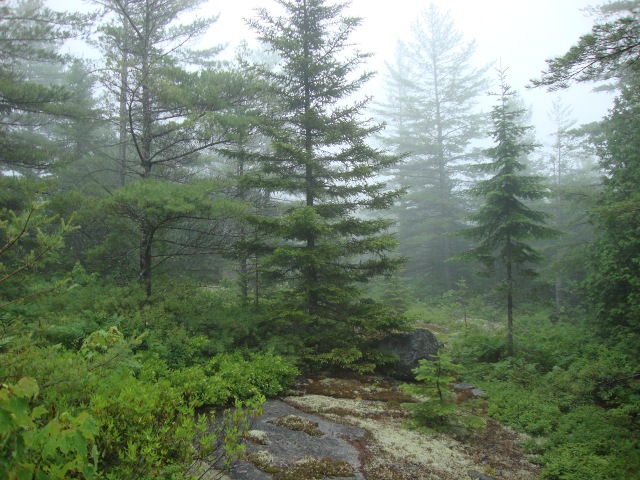 The surreal landscape altered by a wildfire decades ago
The surreal landscape altered by a wildfire decades ago The most rewarding experience of the last two days was slowly walking the top of a few small bulges of the landscape which had been devastated by a forest fire around fifty years ago. The rain and mist combined with the songs of birds to provide me with an almost surreal experience. I must have spent over half an hour just sitting on the open rocks trying to understand what made it so attractive and unreal. I forced myself to consume a logan bread bar before continuing on. My mind had turned its attention toward what I would do after the hike and I, once again, began to make resolutions. The walk toward Hurd Brook was a blur.
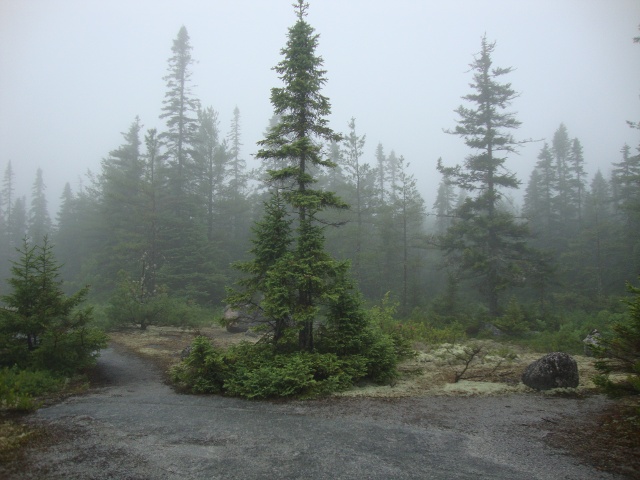 It was easy to just sit, listen, and relax
It was easy to just sit, listen, and relax
Not 100 yards before arriving at Hurd Brook Leanto you are required to cross Hurd Brook which is listed as a ford but actually can be done with some careful boulder hopping. Too focused on the shelter, I jackknifed my foot in a crevice which led me to yelp in pain which caught the attention of the overpopulated shelter. I must have looked absolutely wretched as I limped up to the shelter in the downpour leaning on my hiking pole for support. The occupants were all young, male, and had the same optimism that the other southbound thru-hikers all shared. They were only three miles into the wilderness and their enthusiasm was drowned by the onslaught of two days of rain. While I removed my feet and tended to the blisters they all watched intently - it was the only entertainment to be had. I wished them all luck and gave them a few warnings about the trail ahead before beginning the final miles of the hike.
The last push to Abol was uneventful. I was weary, wet, and tired, but the thought of the end led me onward unfailingly. Closing in on the end of the trail yielded louder and louder sounds of logging trucks barreling across Abol Bridge. As I broke out of the forest and onto the road I finally felt relief and was warmed by a feeling of accomplishment. It was, curiously, not a particularly powerful experience. I suppose that it truly is about the journey and not the destination. I waddled toward my car (which I could not get into) then dragged my soaked body into the camp store where I, disappointingly, found no skittles. I drank a cream soda and ate some chili cheese Fritos.
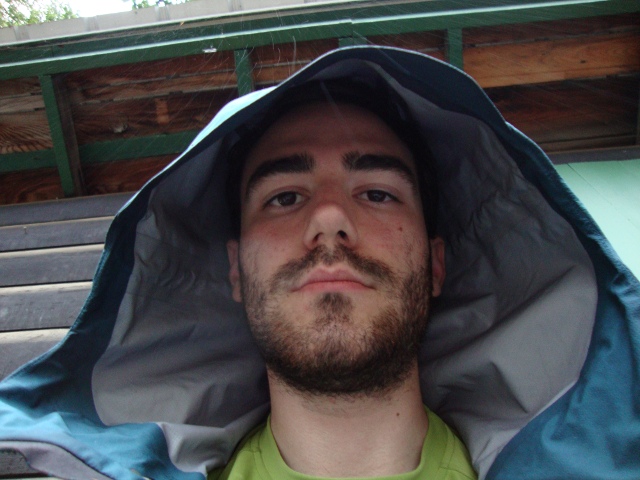 What I looked like waiting in the rain after over 100 miles of hiking and 8 days in the wilderness
What I looked like waiting in the rain after over 100 miles of hiking and 8 days in the wilderness After relaxing a bit I had to decide on a plan of action. I had over 14 hours until Zach would arrive and provide access to the car. I ended up calling Zach in Monson to have him talk to Dawn about what my best option was. She recommended I stay at the AT lodge in Millinocket and I called Paul Renaud who owns and operates the lodge and cafe. He never answered his phone and the pay phone was an annoying contraption that was actually a cell phone. I wasted over $2 attempting to contact him. When he finally picked me up he explained that he can never make out what people say when they use the pay cell phone since the service is so poor. I was picked up at 7:30PM which was quite late and prevented me from getting a proper meal in town. I was so worn and fatigued that I scrapped the whole evening and laid down on the first fresh sheets I had seen since Monson, ME after a long shower. I planned on getting up for a huge breakfast at the AT cafe. I had the entire lodge to myself except for a short, older man who was hiking Katahdin tomorrow to begin his hike to Damascus, VA. He had flip-flopped there when he injured himself and needed surgery during the previous year.
I fell asleep content that I had proved to myself that I could push myself physically and mentally to levels I was not aware I was capable of. A deep longing to return home and to see things that were familiar to me surfaced. I romanticized my return and thought about my cats, my own bed, my family, my friends, and even the predictability and security of my job. I made note of many of the resolutions I made during the last three days of my hike and still felt determined to see some of them through. They had become important to me and an integral part of the experience. I clung to the cotton sheets that had been used and enjoyed by countless battered hikers before me and could not bring myself to use the pillow which now felt uncomfortable to me after over a week of sleeping in the absence of one.
Thursday, June 24
I woke up early and headed to the AT cafe where I ordered an enormous omelet, English muffins, home fries, a fruit cup, and juice. I hadn't eaten for quite some time and gorged myself on the heaping breakfast. I found a small store in town and finally purchased the pack of skittles which I had rightfully earned the previous day. I had no idea when Zach would be arriving at the AT lodge to pick me up so I ate my skittles while completing a 500 piece jigsaw puzzle I found under a stairwell in the lower floor of the lodge. I finished it in just over three and a half hours moments before Zach arrived. We began the long journey home and made sure to stop at a Chipotle in Massachusetts for me to do some much-needed calorie binging. We drove straight through and took turns at the wheel for nearly 21 hours. Zach had stories about interesting hikers he met at Shaw's while I shared tales of the wilderness. As we arrived back at our homes I'm sure we both felt a comforting wave of relief to be reunited with what was familiar and safe.
I will be making one last post of afterthoughts and final words along with a discussion on things that I would change if making the trip again. I am also encouraging Zach to write up an entry about his experience.